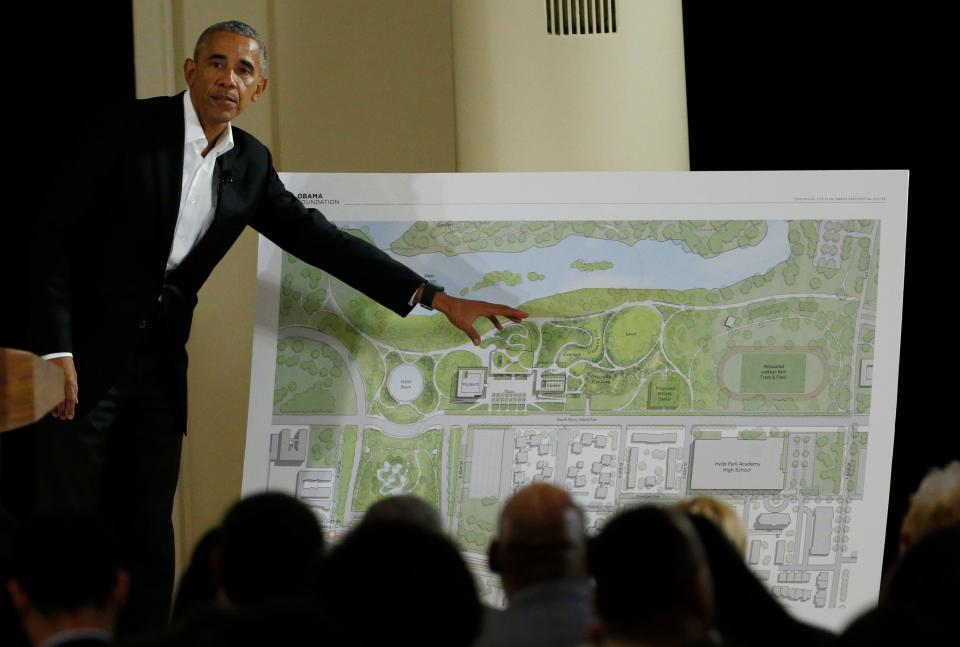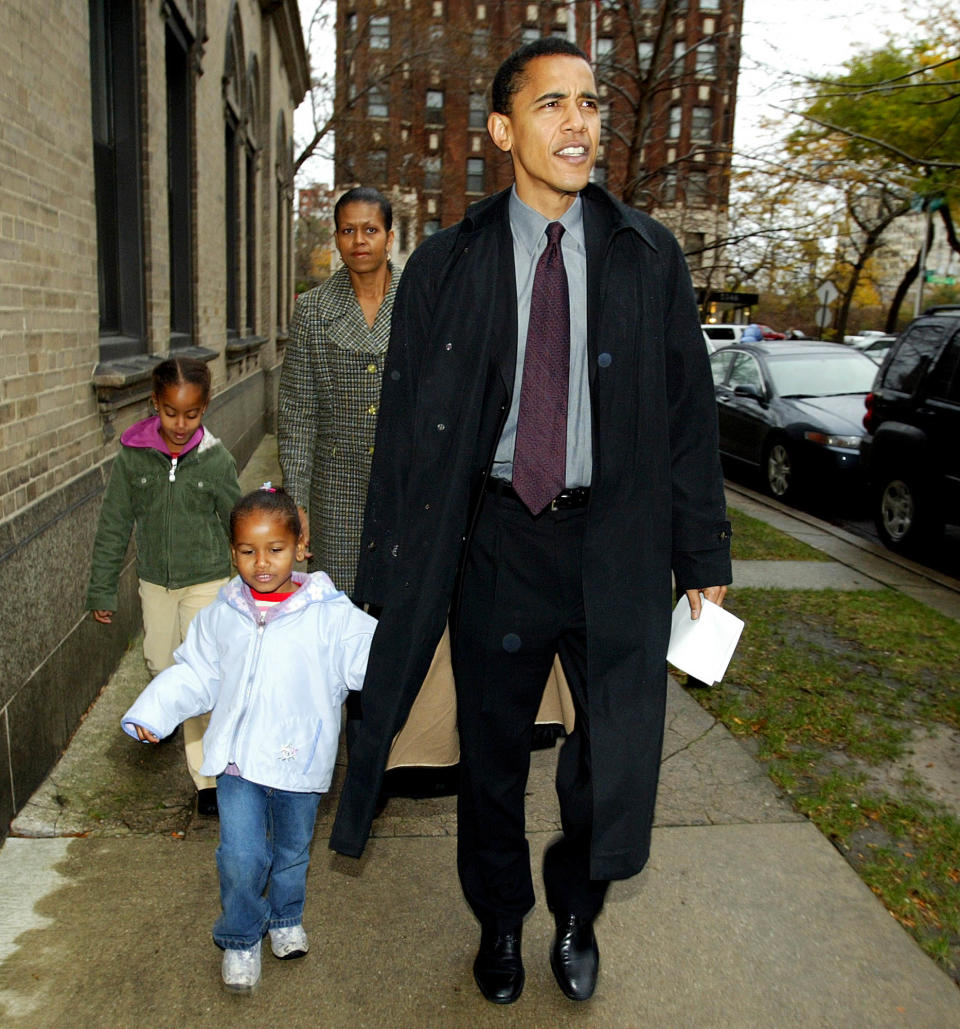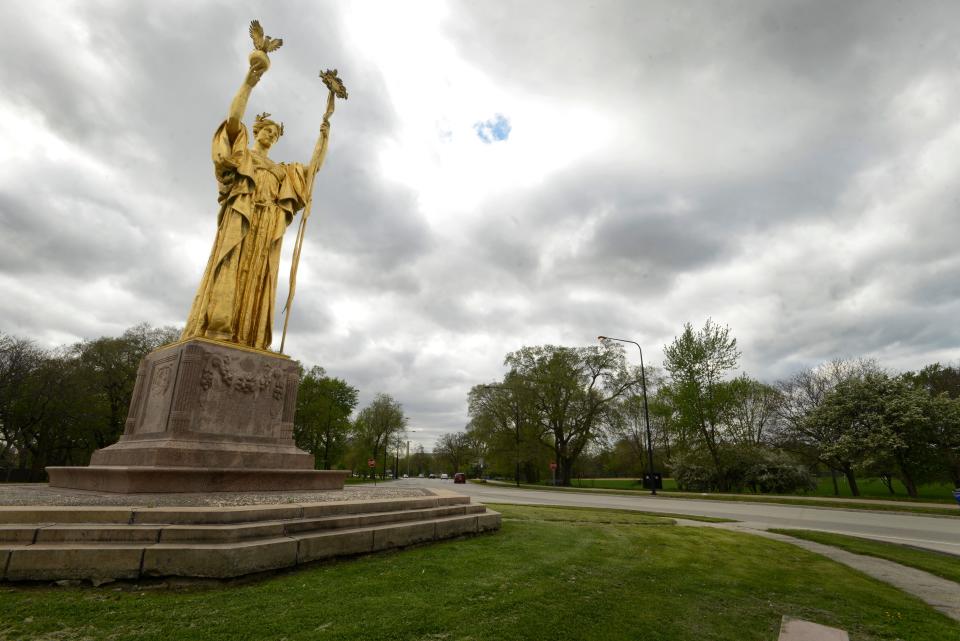Obama Presidential Center expected to break ground this fall after years of opposition, concern
- Oops!Something went wrong.Please try again later.
- Oops!Something went wrong.Please try again later.
CHICAGO – After years of pushback by park preservationists and community groups concerned about displacement, the Obama Presidential Center is expected to break ground this fall, and the former president visited with residents of the area this week.
"Traditionally I think presidential libraries can be a little backward-looking ... kind of a mausoleum in the sense that not much is happening," Barack Obama said Friday at a virtual event hosted by the Economic Club of Chicago. "Our thought was, well, let’s create an institution that is alive and vibrant and is bringing people together."
The $500 million center, designed by architects Todd Williams and Billie Tsien, is expected to be located in Jackson Park on the city's South Side. The center is expected to consist of a museum, forum, public library, plaza, playground and pedestrian and bicycle paths. The Obama Foundation said it hopes the center brings 700,000 people to the South Side every year.
Obama family dog: Bo dies following battle with cancer, Barack and Michelle Obama post tributes
Barack Obama: Malia, Sasha's time in White House 'shut down their interest in public service'

The site will be located near where Barack and Michelle Obama first met, settled down and had their daughters. The location is near the University of Chicago Law School, where Obama taught constitutional law. It's also a few miles from where Michelle grew up and several miles from where Obama worked as a community organizer. Obama represented the area in the Illinois Senate from 1997 until 2004.
This week, Obama met with local business owners in surrounding neighborhoods and made a surprise visit to a youth football team practice. People who live within a two-mile radius of the site are predominantly low-income, according to a 2017 report from the University of Illinois at Chicago, and many live in historically disinvested communites.
"Unfortunately, there are communities that have experienced extraordinary trouble and difficulty for decades," Obama said. "It’s one of the reasons I think the Obama Presidential Center can be a powerful engine. It gives us an opportunity to locate in a community and have a presence that signifies this is an important part of our city."

The Foundation announced the location of the center in 2016, but the project was delayed by a lengthy federal review process required because the center's location, Jackson Park, is included in the National Register of Historic Places. The park was designed by landscape architect Frederick Law Olmsted and remodeled for the 1893 World’s Columbian Exposition.
The National Park Service and Federal Highway Administration concluded their four-year review in February, and Chicago Mayor Lori Lightfoot said physical construction would begin as early as August.
Several local groups, including park preservationists and a coalition of community organizations, have raised concerns about the project for years.
Park preservationists have warned about the effects on the historic parkland and have proposed an alternative location for the center. In 2018, a group led by the nonprofit Protect Our Parks sued the city and the Park District.
"This is a 150-year-old work of art, and it is regarded widely as one of the most magnificent landscaped parks in America," said plaintiff Tom Mitchell, a professor at the University of Chicago who teaches a course on the history of landscape. "It’s going to be a very, very ugly moment when the bulldozers arrive and people see these century-old trees carted away."

In 2020, an appelete court – where Justice Amy Coney Barrett sat at the time – said the suit lacked standing. Last year, the group asked the U.S. Supreme Court to revisit the appellate court decision, but the high court denied the petition in April. Barrett was not involved in the consideration, according to the court.
Michael Rachlis, who is part of the Protect Our Parks legal team, said the group planned to file a preliminary injuction motion before the court this month to request work on the center be stayed.
"If you’re going to try to seize a huge portion of a public park, you should have a very good reason, and there should be no feasible alternatives," Mitchell said. "In this case, there are feasible and superior alternatives."
Valerie Jarrett, president of the Foundation, acknowledged the expected legal action at the virtual event Friday.
"We expect the same small group will sue us again going forward and try to get a restraining order," she said. "But we are very confident we're on solid legal footing."

Meanwhile, a collection of community organizations under the banner of the Obama Community Benefits Agreement Coalition has also voiced concern that longtime residents of the areas surrounding the site are at risk of being priced out of their neighborhoods.
"The reason the center is coming to the South Side is because these are the people who elected Barack Obama. These people shouldn’t be punished for that. They should be able to benefit from what’s going on," said Dixon Romeo, a member of the coaliton and resident of the South Shore neighborhood, where Michelle Obama grew up.
Area residents are predominantly renters, according to the 2017 report. Nearly half of renters have annual incomes less than $20,000, eviction rates are some of the highest in the city, and rent is rising in newly renovated and new construction units, which the majority of current renters cannot afford, according to the report.
Barack Obama on UFOs: 'We can't explain how they move, their trajectory'
'A clarion call for justice': Tracee Ellis Ross, Michelle Obama, more stars honor George Floyd
The coalition launched a years-long campaign demanding a community benefits agreement to protect residents from displacement, and the city and Foundation have since made a series of promises to address the coalition's concerns.
In September, the city adopted an ordinance for the Woodlawn neighborhood mandating affordability requirements on all rental and for-sale housing developed on city-owned residential land and appropriating about $4.5 million – and leveraging another $5 million in loan funds – to help rehabilitate existing affordable housing.
The ordinance also created a "Right of First Refusal Pilot Program" in the neighborhood that would require an owner of a building with 10 or more units to give tenants an exclusive opportunity to make an offer on the property prior to its sale.
However, several other neighborhoods in the area – such as Grand Crossing, South Shore and Hyde Park – have not received similar provisions.
"It (the ordinance) is not enough for Woodlawn, but it’s better than what every other neighborhood got because we all got nothing," Romeo said. "We’re already starting to see the effects and the signs of displacement."
For its part, the Foundation committed to awarding 50% of the subcontracting packages for the center to minority-, women-, or veteran-owned businesses, with 35% of workers living on the South and West Sides. In March, the Foundation created a "We Can Build It Consortium" to get more local residents involved in the building trades and committed $850,000 to train 400 new apprentices from the South and West Sides.
The Foundation also donated up to $3.5 million to the city to cover the cost of construction of the multi-purpose artificial turf field nearby.
"This could mean a transformation of the community, and that transformation is either going to mean equitable development or displacement," Romeo said.
This article originally appeared on USA TODAY: Obama Presidential Center expected to break ground this fall

